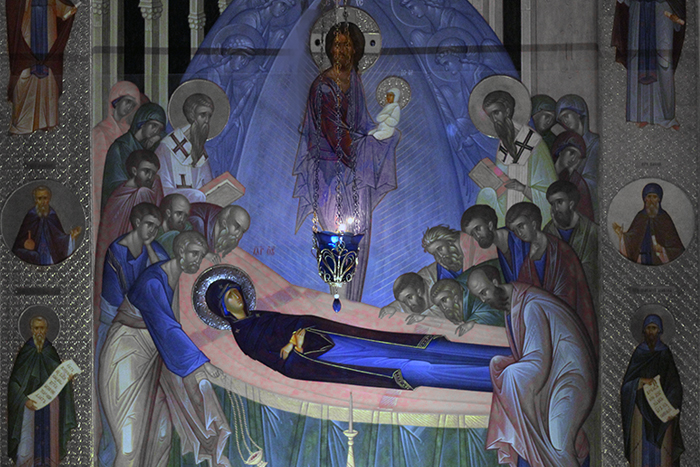
The Ancient Origins of Groundhog Day
Early February is the midpoint between the beginning of winter and the beginning of spring, and we who live in northern climes are ready, more than ready, for winter to be done. We begin to look forward to spring. Pagan pre-Christian Germans observed this time with a celebration called Imbolc (don’t ask), and their weather lore held that if a badger or sacred bear appeared, that would be the sign that spring would come soon. That’s the background of the tale of modern American Groundhog Day, to which we will return later in this article.
The Even More Ancient Origins of the Presentation
But then the great Christian feast of the Presentation of Christ appeared and overshadowed the sacred bear or badger. The origins of the Presentation go back to Old Testament times. The Law (Exodus 13:2) required that firstborn males be consecrated to God. They were presented in the temple on the 40th day after birth. This was part of the Old Testament pattern of offering the first of everything to the Lord. (This, brothers and sisters, is still a good pattern for our charitable giving. We have practiced it from the beginning at Saint Nicholas, Cedarburg – each month 10% off the top to the Archdiocese and 10% more to charity. To this we attribute the fact that we have never had financial problems. “God never allows anyone to outdo him in generosity.”)
Offerings were also made for the ritual “purification” of the mother. The sacrifice was to be 2 turtledoves or 2 young pigeons or, if they could afford it, a lamb. The Holy Family weren’t poor; craftsmen and carpenters aren’t usually poverty stricken. But neither were they rich, so they offered the birds. (Leviticus 12:1-8) To this day in the West this feast is often called the “Purification of the Virgin Mary”. This certainly did not mean that the Theotokos was morally impure or that having babies was somehow indecent. God commanded mankind to “be fruitful and multiply”. But in Judaism (and in some other religions) there was a sort of ritual uncleanness after certain things associated with life forces: sex, childbirth, contact with blood, anointing the dead. This ritual purification did not imply moral impurity. This is very hard for us to understand, since for Christians “all things are pure”. (Titus 1:15) In a slightly similar way we Orthodox fast from certain foods at certain times, but not because they’re evil.
The Presentation of Christ in the Temple (Luke 2:22-40) is one of the most ancient Christian feasts. Records suggest that it may have been celebrated even before Christmas was. It has a complicated history. We get the first information about it from Mother Egeria, a Spanish nun who In the late 4th century visited Jerusalem and wrote a description of worship in the Mother Church. (Her account of Holy Week and Pascha is very interesting, even moving.) She said that in Jerusalem the Presentation was celebrated exactly 40 days after Christ’s birth, namely on February 14! because in the East Christmas and Epiphany, the Birth and the Baptism of Christ, were then observed together on January 6. Meanwhile, the Roman Church had their own date for Christmas, borrowed from the pagan Roman feast of the Winter Solstice, Sol Invictus, the Unconquered Sun. So in the West the date for the Presentation would come on February 2. In time, for reasons not clear, the Western dating spread East and prevailed, and eventually all Christians celebrated the Birth of Christ on December 25 and his Presentation on February 2. And that’s what we still do today.
The Presentation – a Wonderful Mutifaceted Feast
In the East this day popularly came to be called The Meeting – the meeting of Christ with Simeon the Elder. The beautiful song of Simeon is sung at every Orthodox Vespers and throughout the Christian world. Here are 3 very different examples:
In the West the feast also came to be called Candlemas (“Candle Mass,” like “Christ Mass”), when candles for use in the church and at home were blessed, for Christ came as “a light to lighten the Gentiles”. This was the ancient practice in Jerusalem. It’s still in the Orthodox books, but I think not many Orthodox do it. At Saint Nicholas, Cedarburg, Father David is going to bless candles this year.
All the Church’s Great Feasts are not only about what happened to people long ago, but also what happens now. This is especially clear in the feast of Christ’s Presentation. We are the Theotokos: Christ dwells in us also. We carry Christ into our temple at every Liturgy and present him to the Father. We are Christ himself: We are the Body of Christ, the Church, and we are presented in this temple: At the Great Entrance each of us in spirit is carried up to the altar under the forms of those little particles of bread on the diskos, and we are offered to the Father. We are Simeon. Here in the Holy Eucharist, we see and receive our salvation, Christ the light of the world, and now we can depart in peace.
The feast of the Presentation has yet another aspect – for it falls approximately midway between Christmas and Pascha, and it marks the end of the Church’s Nativity Cycle and the beginning of our Paschal Cycle. It is a sort of lovely “flashback” to Christmas. Though in our Sunday Scripture readings, Jesus has now long since begun his public ministry, now suddenly for a little while we remember him as an infant again – as if that sweet memory is too precious to put away quite yet. And then we turn the other way. It is time that we must look towards Pre-Lent and Lent and Holy Week and the Cross – and finally towards Christ’s Holy Resurrection. The Troparion for the Presentation expresses this clearly: “Rejoice, O Virgin Theotokos who art full of grace, for from thee shone forth the Sun of Righteousness, Christ who is our God, a light to those who dwell in darkness. Rejoice and be glad, O righteous aged Simeon, bearing in thine arms the Deliverer of our souls, who grants to us resurrection.”
I’ve gone on forever describing the feast of the Presentation, because it is so beautiful, so rich, so deep, with so many meanings, a jewel with so many sides. And also because it is such a loss that it is so neglected these days.
Now finally we’re coming the to the groundhog. For the feast of the Meeting, in the northern hemisphere at least, also stands at the borderline between the winter solstice and the spring equinox, when we look forward to the death of winter and the resurrection of nature. One of our early Lenten hymns begins: “The Lenten Spring has come..!” Even if there is still snow on the ground, the springtime of our souls is upon us, and soon the springtime of nature. Come, blessed spring!
Which is to say, the Presentation comes at about the time when the German badger or sacred bear emerged. This harmless custom apparently continued there through the Christian era. Does it still? And now comes the story of the groundhog.
![]()
How the Groundhog stole the Presentation
What if the feast of the Presentation were no longer celebrated? What if people no longer flocked to church on February 2? That is what happened in most of northern Europe after the Protestant Reformation, Even in denominations where the feast was formally retained, nobody paid much attention to it. But people were so accustomed to having this winter-to-spring celebration on February 2. What was left was this ancient animal lore and it was transferred to that date. And then German Protestants brought it to America.
This presented a problem. Badgers? They’re hard to come by here, for they are reclusive nocturnal animals. I live in Wisconsin, the “Badger State”, where everything is named after the badger: our University of Wisconsin football team (”Go Badgers!” and they certainly did this year), Badger Coach Lines, Badger Cross Fit Gym, Badger Car Repairs, Badger Cleaners. (I always think there can’t be much call for that!) But hardly anybody has ever seen one. Nor do I care to. They are nasty. They bite. And I think there are relatively few sacred bears on this side of the Atlantic. (Native Americans have some, but German immigrants wouldn’t know about that.) So in the late 1800s some Germans in Pennsylvania substituted the lowly rather repulsive groundhog, sometimes called the woodchuck, which can easily sbe found burrowing all over North America – and they celebrated it on February 2. In the 1800s only a few churches in America observed the Presentation of Christ – Roman Catholics who then were suspect and easily ignored, no Orthodox except in Alaska where everybody knew spring was many months away, and Anglicans and Lutherans who largely ignored the day. That left February 2 belonging to the Sacred Rodent.
Every February 2 the Groundhog Club of Punxutawny, Pennsylvania, sponsors Groundhog Day, with feasting and various other events, and they pull the poor animal out of his lair. It is said (for reasons I doubt even God knows) that if he sees his shadow there will be 4 more weeks of winter, and if he does not see his shadow there will be 6 more weeks of winter. Or is it the other way around? No matter, it never works out, and no one takes this seriously. Sleepy groundhogs are now pulled from their winter holes in many places around the country. A few years ago in Sun Prairie, Wisconsin, the center of Badgerdom, as the mayor of the city held the groundhog, the rodent bit him in the ear.
Good! I’d do the same thing if someone pulled me out of my home at this time of year. Moral: Don’t hold groundhogs. Other than that, I think Groundhog Day is harmless. Nobody is actually venerating groundhogs.
OK, I don’t want to sound pompous about this. I just wish that all this groundhog commotion didn’t take place on February 2 – for here traditional Christianity once again bites the dust, this time overtaken by rodents. Now, instead of people flocking to church for the feast of the Presentation, people flock to watch groundhog holes! Once again I do wonder what future students of American society will make of this. “Did they actually worship rodents?” By our behavior on February 2, they would certainly never suspect that we worship Christ our God.
Brothers and sisters, do your part to fight the rodent! Go to Divine Liturgy on the feast of the Presentation of our Lord Jesus Christ, his Meeting with Simeon, the Purification of the Theotokos. Ask your priest to bless some candles for Christ the Light of the World. Turn your heart and mind not towards groundhogs being dragged out of their holes, but towards Christ emerging from the tomb – towards his Holy Resurrection.



